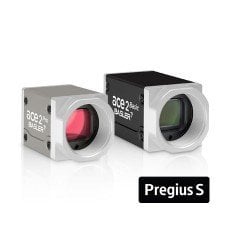www.industry-asia-pacific.com
11
'20
Written on Modified on
HIGH RESOLUTION AND LOW PRICE: NEW ACE 2 USES THE STRENGTHS OF SONY'S PREGIUS S SENSORS
Basler is expanding its ace 2 camera series with 24 models featuring the Sony Pregius S sensors IMX540, IMX541, and IMX542. The combination of small pixel size, backside-illuminated structure (BSI), and global shutter summarizes the most important new features of Sony's 4th generation sensors. With 16 to 24 megapixels, the new ace 2 Basic and ace 2 Pro models maximize the possible resolution in a C-mount format.

The new camera models are equipped with the following sensors from Sony's Pregius S Series:
- IMX540 with 24 megapixel resolution (5328 x 4608 pixels)
- IMX541 with 20 megapixel resolution (4512 x 4512 pixels) and
- IMX542 with 16 megapixel resolution (5320 x 3040 pixels).
Depending on resolution and interface (USB 3.0 / GigE), the cameras deliver frame rates of 4 to 23 frames per second.
Price advantage due to high number of small pixels and reduced hardware
"Our customers benefit in three ways: The strengths of the price-optimized ace 2 Basic and the powerful ace 2 Pro, coupled with the innovative new features in Sony's latest sensor generation, have a direct impact on productivity, price, and precision," explains Michael Rieck, Product Manager for Basler's ace 2 camera series. "The small pixels and compact sensor size meet the need for high-resolution cameras in spatially limited environments, for example in embedded vision systems. At the same time, hardware costs can be reduced, for example, by having one 24 MP camera replace two 12 MP cameras," emphasizes Rieck.
High resolution, no motion artifacts
The combination of BSI and Global Shutter in particular is new and innovative in technological terms: it ensures recordings without any motion artifacts even at high speeds.
Thanks to the modified pixel architecture of Sony's backside-illuminated structure, the light sensitivity of the sensor remains at a similarly high level as with sensors of previous generations, even with the significantly smaller pixel size of 2.74 µm. The higher number of small pixels on the sensor surface increases the resolving power up to 24 megapixels - in combination with a suitable lens from Basler's accessories portfolio, even the smallest details can be seen more precisely. This takes into account the trend toward miniaturization of components and allows a very low price per megapixel resolution.
www.baslerweb.com
Price advantage due to high number of small pixels and reduced hardware
"Our customers benefit in three ways: The strengths of the price-optimized ace 2 Basic and the powerful ace 2 Pro, coupled with the innovative new features in Sony's latest sensor generation, have a direct impact on productivity, price, and precision," explains Michael Rieck, Product Manager for Basler's ace 2 camera series. "The small pixels and compact sensor size meet the need for high-resolution cameras in spatially limited environments, for example in embedded vision systems. At the same time, hardware costs can be reduced, for example, by having one 24 MP camera replace two 12 MP cameras," emphasizes Rieck.
High resolution, no motion artifacts
The combination of BSI and Global Shutter in particular is new and innovative in technological terms: it ensures recordings without any motion artifacts even at high speeds.
Thanks to the modified pixel architecture of Sony's backside-illuminated structure, the light sensitivity of the sensor remains at a similarly high level as with sensors of previous generations, even with the significantly smaller pixel size of 2.74 µm. The higher number of small pixels on the sensor surface increases the resolving power up to 24 megapixels - in combination with a suitable lens from Basler's accessories portfolio, even the smallest details can be seen more precisely. This takes into account the trend toward miniaturization of components and allows a very low price per megapixel resolution.
www.baslerweb.com

